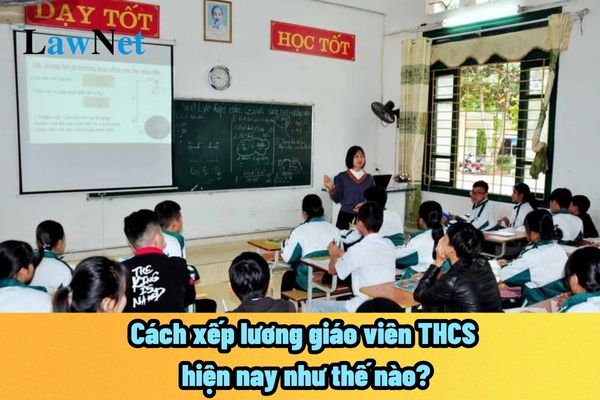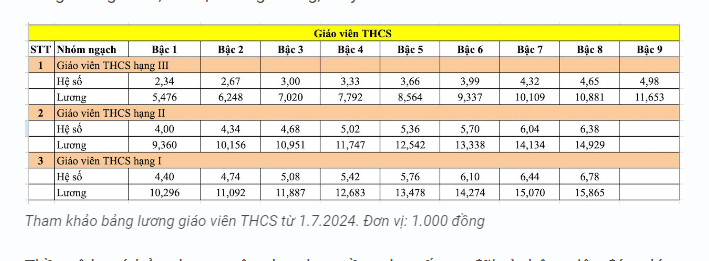Vietnam: How is the salary of lower secondary school teachers currently determined? What is the new salary level for lower secondary school teachers in 2024?
How is the salary of lower secondary school teachers currently determined?
Pursuant to Article 8 of Circular 03/2021/TT-BGDDT of the Ministry of Education and Training of Vietnam, the arrangement of salaries for secondary school teachers is stipulated as follows:
Salary arrangement
1. Public employees appointed to the professional titles of secondary school teachers as regulated in this Circular shall adopt the corresponding salary scales issued together with Decree No. 204/2004/ND-CP, dated December 14, 2004, of the Government of Vietnam on salary policies for officials, public employees, and armed forces. Specifically:
a) Secondary school teacher grade III, code V.07.04.32, adopts the salary coefficient of public employees type A1, from salary coefficient 2.34 to salary coefficient 4.98;
b) Secondary school teacher grade II, code V.07.04.31, adopts the salary coefficient of public employees type A2, group A2.2, from salary coefficient 4.00 to salary coefficient 6.38;
c) Secondary school teacher grade I, code V.07.04.30, adopts the salary coefficient of public employees type A2, group A2.1, from salary coefficient 4.4 to salary coefficient 6.78.
2. The arrangement of salaries upon appointment to the professional title ranks shall follow the guidance in item 1, Section II of Circular No. 02/2007/TT-BNV dated May 25, 2007, of the Ministry of Home Affairs guiding the salary arrangement when raising grades, transferring grades, and transferring types of officials and public employees, and according to the current legal regulations. When implementing new salary policies, the arrangement to new salaries shall follow the regulations of the Government of Vietnam.
In 2024, the salary coefficients for secondary school teachers are:
- Secondary school teacher grade III, code V.07.04.32, adopts the salary coefficient of public employees type A1, from salary coefficient 2.34 to salary coefficient 4.98;
- Secondary school teacher grade II, code V.07.04.31, adopts the salary coefficient of public employees type A2, group A2.2, from salary coefficient 4.00 to salary coefficient 6.38;
- Secondary school teacher grade I, code V.07.04.30, adopts the salary coefficient of public employees type A2, group A2.1, from salary coefficient 4.4 to salary coefficient 6.78.
In summary, the arrangement of salaries for secondary school teachers is currently divided according to the ranks of secondary school teachers.

How are secondary school teachers' salaries currently arranged? New salary for secondary school teachers in 2024? (Image from Internet)
What is the new salary level for lower secondary school teachers in 2024?
Regarding salary reform; adjustment of retirement pensions, social insurance benefits, preferential allowances for people with meritorious services, and social allowances from July 01, 2024.
Article 3 of Decree 73/2024/ND-CP stipulates the statutory pay rate as follows:
Statutory pay rate
1. The statutory pay rate is used as a basis for:
a) Calculating salaries in the salary scales, allowances, and implementing other policies according to the law for the subjects regulated in Article 2 of this Decree;
b) Calculating operating costs and living expenses as stipulated by law;
c) Calculating deductions and benefits based on the statutory pay rate.
2. From July 01, 2024, the statutory pay rate is 2,340,000 VND/month.
...
The new salary scale for secondary school teachers from July 01, 2024, will adjust the statutory pay rate from 1.8 million VND to 2.34 million VND (an increase of 30%) as stipulated in Article 3 of Decree 73/2024/ND-CP.
Secondary school teachers' salaries from July 01, 2024, after salary reform, will be calculated as per Article 3 of Circular 07/2024/TT-BNV as follows:
Salary = 2,340,000 VND x Salary Coefficient

Thus, according to the regulations, the new salary for secondary school teachers in 2024 will increase from 1.8 million VND to 2.34 million VND (an increase of 30%).
What is the current level of allowances granted to lower secondary school teachers?
According to Article 2 of Decision 244/2005/QD-TTg of the Prime Minister of Vietnam, the regulations are as follows:
Preferential allowance aate and calculation thereof
1. The preferential allowance rates for educators are regulated as follows:
a) The allowance rate of 25% is applied to educators directly teaching in universities, colleges, academies, training schools of Ministries, Government agencies, Communist Party organizations, central socio-political organizations, and political schools of provinces and centrally run cities (excluding educators teaching in pedagogical schools, pedagogical faculties, and educators teaching Marx-Lenin Science and Ho Chi Minh Thought);
b) The allowance rate of 30% is applied to educators directly teaching in secondary schools*, high schools, comprehensive technical - vocational centers, continuing education centers, vocational training centers in plains, cities, district-level towns; secondary vocational schools, vocational training schools; political training centers of districts, districts, district-level towns, cities under provincial level;*
c) The allowance rate of 35% is applied to educators directly teaching in kindergartens, primary schools in plains, cities, district-level towns; secondary schools*, high schools, comprehensive technical - vocational centers, continuing education centers, vocational training centers in mountainous, island, remote, and isolated areas;*
d) The allowance rate of 40% is applied to educators directly teaching in pedagogical schools, pedagogical faculties (university, college, secondary level), educational management and training schools, and educators teaching political subjects in secondary vocational schools, vocational training schools;
đ) The allowance rate of 45% is applied to educators directly teaching Marx-Lenin Science and Ho Chi Minh Thought in universities and colleges;
e) The allowance rate of 50% is applied to educators directly teaching in kindergartens, primary schools in mountainous, island, remote, and isolated areas.
2. The preferential allowance rates stipulated in item 1 of this Article are calculated based on the current salary scale according to grade, rank plus leadership allowance, over-frame seniority allowance (if any).
Thus, according to the regulations, educators directly teaching in secondary schools can receive a preferential allowance rate of 30%.
Educators directly teaching in secondary schools in mountainous, island, remote, and isolated areas can receive a preferential allowance rate of 35%.

